GENGHIS KHAN TRIVIA
c. 1162 – August 18, 1227
Between 1206 and his death in 1227, the Mongol leader Genghis
Khan conquered nearly 12 million square miles of territory—more than any
individual in history. Along the way, he cut a ruthless path through Asia
and Europe that left untold millions dead, but he also modernized Mongolian
culture, embraced religious freedom and helped open contact between East
and West. He was a great ruler who was equal parts military genius, political
statesman and bloodthirsty terror.
1. “Genghis” wasn’t his real name.
The man who would become the “Great Khan” of the Mongols
was born along the banks of the Onon River sometime around 1162 and originally
named Temujin, which means “of iron” or “blacksmith.” He didn’t get the
honorific name “Genghis Kahn” until 1206, when he was proclaimed leader
of the Mongols at a tribal meeting known as a “kurultai.” While “Khan”
is a traditional title meaning “leader” or “ruler,” historians are still
unsure of the origins of “Genghis.” It may have may have meant “ocean”
or “just,” but in context it is usually translated as “supreme ruler” or
“universal ruler.”
2. He had a rough childhood.
From an early age, Genghis was forced to contend with
the brutality of life on the Mongolian Steppe. Rival Tatars poisoned his
father when he was only nine, and his own tribe later expelled his family
and left his mother to raise her seven children alone. Genghis grew up
hunting and foraging to survive, and as an adolescent he may have even
murdered his own half-brother in a dispute over food. During his teenage
years, rival clans abducted both he and his young wife, and Genghis spent
time as a slave before making a daring escape. Despite all these hardships,
by his early 20s he had established himself as a formidable warrior and
leader. After amassing an army of supporters, he began forging alliances
with the heads of important tribes. By 1206, he had successfully consolidated
the steppe confederations under his banner and began to turn his attention
to outside conquest.
3. There is no definitive record of what he looked
like.
For such an influential figure, very little is known
about Genghis Kahn’s personal life or even his physical appearance. No
contemporary portraits or sculptures of him have survived, and what little
information historians do have is often contradictory or unreliable. Most
accounts describe him as tall and strong with a flowing mane of hair and
a long, bushy beard. Perhaps the most surprising description comes courtesy
of the 14th century Persian chronicler Rashid al-Din, who claimed Genghis
had red hair and green eyes. Al-Din’s account is questionable—he never
met the Khan in person—but these striking features were not unheard of
among the ethnically diverse Mongols.
4. Some of his most trusted generals were former enemies.
The Great Khan had a keen eye for talent, and he usually
promoted his officers on skill and experience rather than class, ancestry
or even past allegiances. One famous example of this belief in meritocracy
came during a 1201 battle against the rival Taijut tribe, when Genghis
was nearly killed after his horse was shot out from under him with an arrow.
When he later addressed the Taijut prisoners and demanded to know who was
responsible, one soldier bravely stood up and admitted to being the shooter.
Stirred by the archer’s boldness, Genghis made him an officer in his army
and later nicknamed him “Jebe,” or “arrow,” in honor of their first meeting
on the battlefield. Along with the famed general Subutai, Jebe would go
on to become one of the Mongols’ greatest field commanders during their
conquests in Asia and Europe.
5. He rarely left a score unsettled.
Genghis Khan often gave other kingdoms a chance to peacefully
submit to Mongol rule, but he didn’t hesitate to bring down the sword on
any society that resisted. One of his most famous campaigns of revenge
came in 1219, after the Shah of the Khwarezmid Empire broke a treaty with
the Mongols. Genghis had offered the Shah a valuable trade agreement to
exchange goods along the Silk Road, but when his first emissaries were
murdered, the enraged Khan responded by unleashing the full force of his
Mongol hordes on the Khwarezmid territories in Persia. The subsequent war
left millions dead and the Shah’s empire in utter ruin, but the Khan didn’t
stop there. He followed up on his victory by returning east and waging
war on the Tanguts of Xi Xia, a group of Mongol subjects who had refused
his order to provide troops for his invasion of Khwarizm. After routing
the Tangut forces and sacking their capital, the Great Khan ordered the
execution of the entire Tangut royal family as punishment for their defiance.
6. He was responsible for the deaths of as many as
40 million people.
While it’s impossible to know for sure how many people
perished during the Mongol conquests, many historians put the number at
somewhere around 40 million. Censuses from the Middle Ages show that the
population of China plummeted by tens of millions during the Khan’s lifetime,
and scholars estimate that he may have killed a full three-fourths of modern-day
Iran’s population during his war with the Khwarezmid Empire. All told,
the Mongols’ attacks may have reduced the entire world population by as
much as 11 percent.
7. He was tolerant of different religions.
Unlike many empire builders, Genghis Khan embraced the
diversity of his newly conquered territories. He passed laws declaring
religious freedom for all and even granted tax exemptions to places of
worship. This tolerance had a political side—the Khan knew that happy subjects
were less likely to rebel—but the Mongols also had an exceptionally liberal
attitude towards religion. While Genghis and many others subscribed to
a shamanistic belief system that revered the spirits of the sky, winds
and mountains, the Steppe peoples were a diverse bunch that included Nestorian
Christians, Buddhists, Muslims and other animistic traditions. The Great
Khan also had a personal interest in spirituality. He was known to pray
in his tent for multiple days before important campaigns, and he often
met with different religious leaders to discuss the details of their faiths.
In his old age, he even summoned the Taoist leader Qiu Chuji to his camp,
and the pair supposedly had long conversations on immortality and philosophy.
8. He created one of the first international postal
systems.
Along with the bow and the horse, the Mongols most potent
weapon may have been their vast communication network. One of his earliest
decrees as Khan involved the formation of a mounted courier service known
as the “Yam.” This medieval express consisted of a well-organized series
of post houses and way stations strung out across the whole of the Empire.
By stopping to rest or take on a fresh mount every few miles, official
riders could often travel as far as 200 miles a day. The system allowed
goods and information to travel with unprecedented speed, but it also acted
as the eyes and ears of the Khan. Thanks to the Yam, he could easily keep
abreast of military and political developments and maintain contact with
his extensive network of spies and scouts. The Yam also helped protect
foreign dignitaries and merchants during their travels. In later years,
the service was famously used by the likes of Marco Polo and John of Plano
Carpini.
9. No one knows how he died or where he is buried.
Of all the enigmas surrounding the Khan’s life, perhaps
the most famous concerns how it ended. The traditional narrative says he
died in 1227 from injuries sustained in a fall from a horse, but other
sources list everything from malaria to an arrow wound in the knee. One
of the more questionable accounts even claims he was murdered while trying
to force himself on a Chinese princess. However he died, the Khan took
great pains to keep his final resting place a secret. According to legend,
his funeral procession slaughtered everyone they came in contact with during
their journey and then repeatedly rode horses over his grave to help conceal
it. The tomb is most likely on or around a Mongolian mountain called Burkhan
Khaldun, but to this day its precise location is unknown.
10. The Soviets tried to snuff out his memory in Mongolia.
Genghis Khan is now seen as a national hero and founding
father of Mongolia, but during the era of Soviet rule in the 20th century,
the mere mention of his name was banned. Hoping to stamp out all traces
of Mongolian nationalism, the Soviets tried to suppress the Khan’s memory
by removing his story from school textbooks and forbidding people from
making pilgrimages to his birthplace in Khentii. Genghis Khan was eventually
restored to Mongolian history after the country won independence in the
early 1990s, and he’s since become a recurring motif in art and popular
culture. The Great Khan lends his name to the nation’s main airport in
the city of Ulan Bator, and his portrait even appears on Mongolian currency.
11. "Super Father" Genghis Khan
has
up to 16 million male descendants: See ERBzine
5880a
www.erbzine.com/mag58/5880a.html
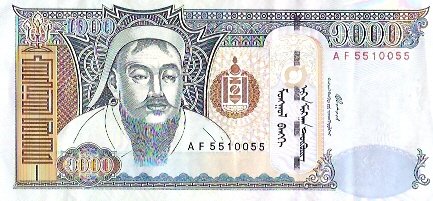
Genghis Khan on the Mongolian 1,000 tögrög banknote




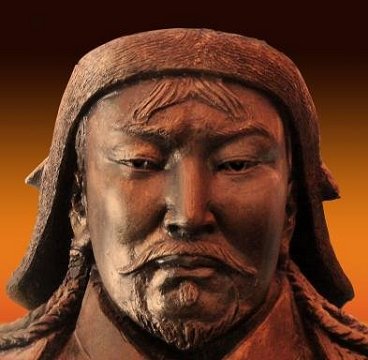

![]()
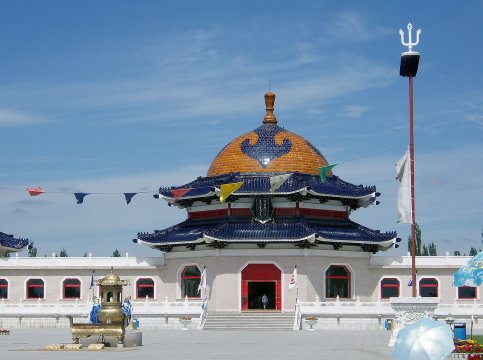
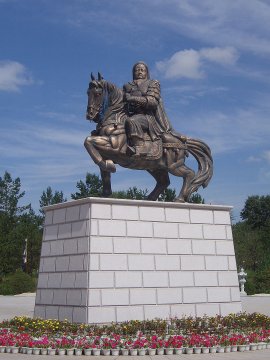
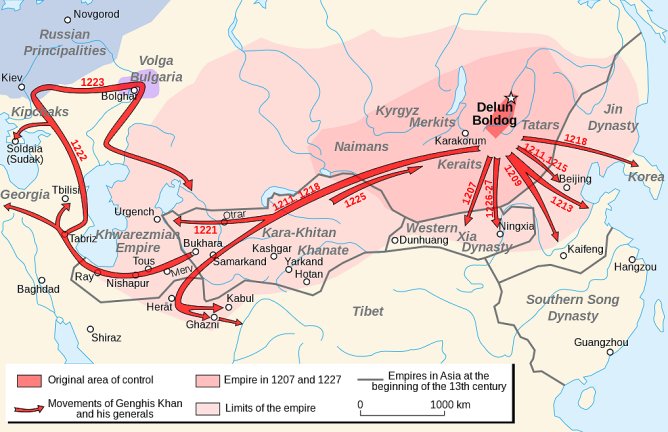
![]()

![]()